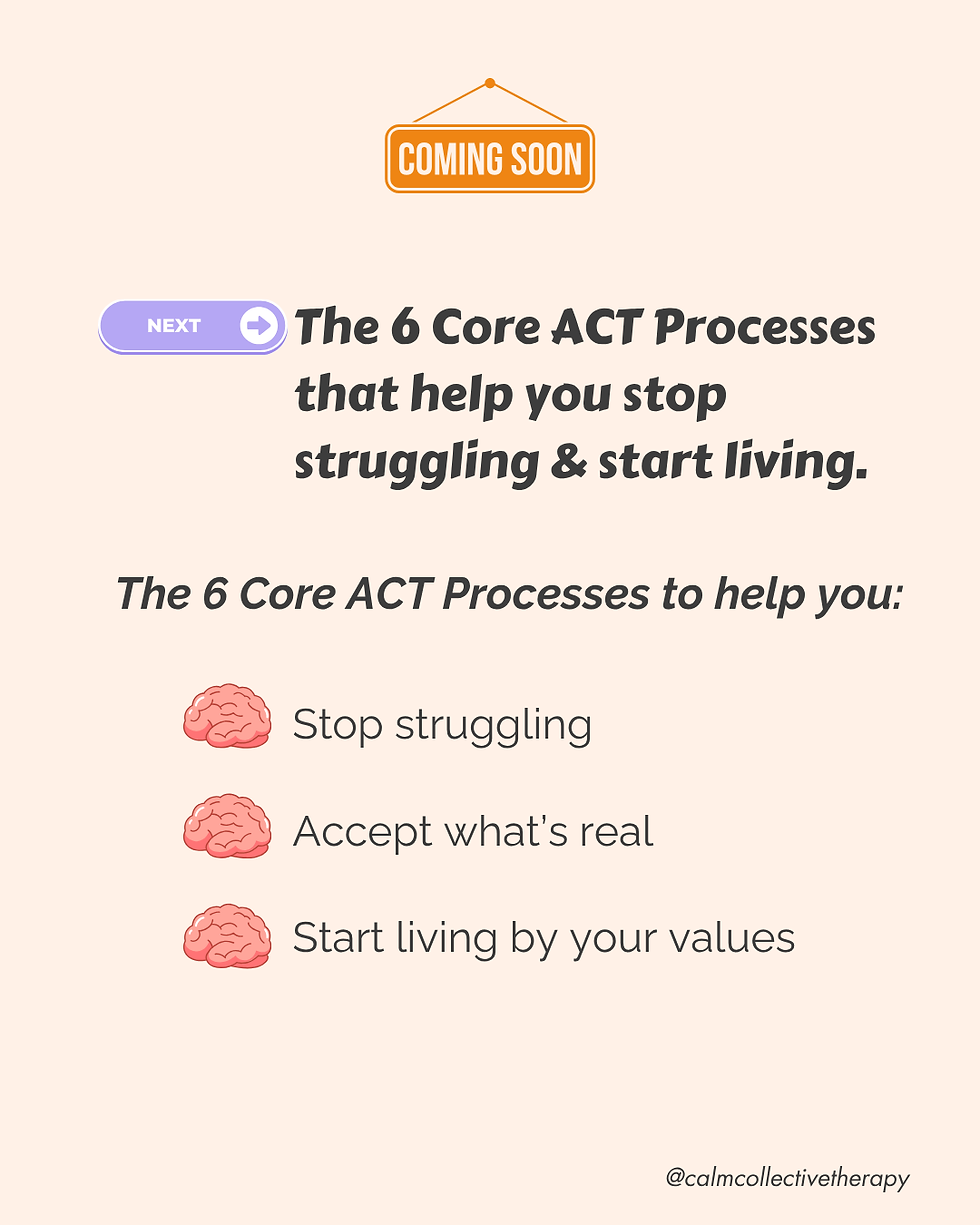ACT: Finding Meaning Beyond Inner Struggles
- Calm Collective

- Jul 29
- 4 min read

Think about the last time you or someone else said, “Just look on the bright side,” or “It’s not that bad, just think positive.” Chances are, it wasn’t long ago. Maybe you even heard it said to you today! While it's true that these kinds of statements can sometimes help put things in perspective, they aren’t always effective, especially in moments of distress. In fact, overly positive thinking can invalidate genuine feelings, a phenomenon known as toxic positivity.
Many people are now recognizing that this approach doesn’t always serve them. This realization isn’t new. Eastern philosophies have long emphasized mindfulness: noticing thoughts and emotions without judgment, rather than trying to change them. For those who feel connected to this type of approach, many report to feeling more aligned and attuned with themselves and others. However, one might ask: how do I start merging Eastern and Western philosophies?
The answer? Acceptance and Commitment Therapy (ACT; pronounced as ‘act’): a modern therapeutic approach that actually draws from both Western and Eastern traditions.
What is ACT?
ACT, or Acceptance and Commitment Therapy, is a mindfulness-based behavioral approach that focuses on building psychological flexibility. ACT aims to shift the focus from symptom reduction to helping individuals live in alignment with their values — even in the presence of difficult emotions. Developed by Steven C. Hayes as part of the “third wave” of behavioral therapies, ACT stands apart from approaches like CBT by emphasizing acceptance over avoidance or cognitive reframing (Hayes, 2005).

If you’re used to avoiding uncomfortable emotions, you might wonder, “Why would I choose to feel something I hate?” It’s a fair question. But consider: has pushing those feelings away actually made them disappear? Or do they tend to resurface — sometimes more intensely — despite distractions, habits, or even positive thinking? You might notice that even avoidance has its limitations, and your intrusive thoughts can still seep through, hard as you try. This is where ACT might offer a new way to relate to your inner experience.
To better understand ACT, it helps to look at its foundation and six core processes. At its heart, ACT is based on the idea that acceptance and mindfulness can be more effective for navigating life’s difficulties than rigid thinking or constant problem-solving. When people allow themselves to fully acknowledge their situations—without immediately trying to judge or change them—they often experience less emotional suffering.

Of course, this shift isn’t easy, especially in a culture focused on fixing or escaping discomfort. As Hayes et al. (2011) point out, many spiritual and cultural traditions recognize that psychological processes are both necessary and complex—yet much of psychology has historically tried to eliminate them. ACT challenges that trend by suggesting that suffering doesn’t always have to be minimized through control. Instead, we can choose to hold our difficult thoughts as they are and still take action aligned with our values—often leading to more sustainable, meaningful change with less inner struggle.

Another core component of ACT is its emphasis on the power of human language. According to Hayes et al. (2011), language—whether expressed through words, sounds, gestures, or images—can be both a source of human achievement and of suffering. As meaning-making beings, we often interpret current painful events through the lens of past experiences, noticing patterns and making predictions about what might happen next. While this can be adaptive at times, it can also disconnect us from the present moment and limit our ability to respond to situations as they truly are, rather than how we fear or assume they will be.

The creators of ACT suggest that this tendency to narrate and interpret our experiences—across past, present, and future—can actually amplify our suffering, especially when we try to control or eliminate pain through avoidance, distraction, or forced reframing. Hayes et al. (2011) emphasize that acknowledging the inevitability of life’s challenges and allowing them to unfold naturally can help us begin to disentangle from the unhelpful grip of our minds—one of ACT’s central aims.
ACT also encourages individuals to become more discerning about when it’s helpful to listen to the mind (e.g., when crossing a busy street or doing taxes) and when it’s more beneficial to allow thoughts to come and go—particularly during painful, yet natural, psychological experiences that don't require problem-solving but presence and acceptance. Learning to navigate thoughts in this way lays the groundwork for a deeper aspect of ACT: making space for pain and inner struggles without letting them dictate the direction of our lives.

In our next blog post, we'll explore how ACT can help us hold on to pain and life's challenges, and still keep moving forward with mindful intention. We hope you'll join us for the next post in this series!
Written by: Michelle Latorres, LMHC
Calm Collective Therapy
Sources:
Aravind A, Agarwal M, Malhotra S, Ayyub S. Effectiveness of Acceptance and Commitment Therapy on Mental Health Issues: A Systematic Review. Ann Neurosci. 2024 Dec 18:09727531241300741. doi: 10.1177/09727531241300741. Epub ahead of print. PMID: 39703872; PMCID: PMC11653371.
A-Tjak, J. G., Davis, M. L., Morina, N., Powers, M. B., Smits, J. A., & Emmelkamp, P. M. (2015). A meta-analysis of the efficacy of acceptance and commitment therapy for clinically relevant mental and physical health problems. Psychotherapy and psychosomatics, 84(1), 30–36. https://doi.org/10.1159/000365764
Zhao, B., Wang, Q., Wang, L. et al. Effect of acceptance and commitment therapy for depressive disorders: a meta-analysis. Ann Gen Psychiatry 22, 34 (2023). https://doi.org/10.1186/s12991-023-00462-1
Hayes, S. C., Strosahl, K. D., & Wilson, K. G. (1999). Acceptance and commitment therapy: An experiential approach to behavior change. Guilford Press.
Hayes, S.C., Strosahl, K.D., Wilson, K.G. (2011). Acceptance and Commitment Therapy, Second Edition: The Process and Practice of Mindful Change. Guilford Press.
Hayes, S. C. (2005). Get out of your mind and into your life: The new acceptance and commitment therapy. New Harbinger Publications.



Comments